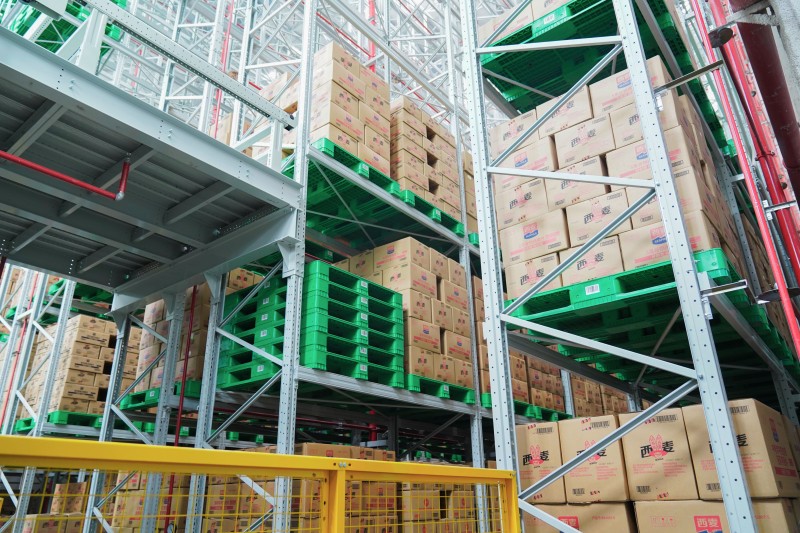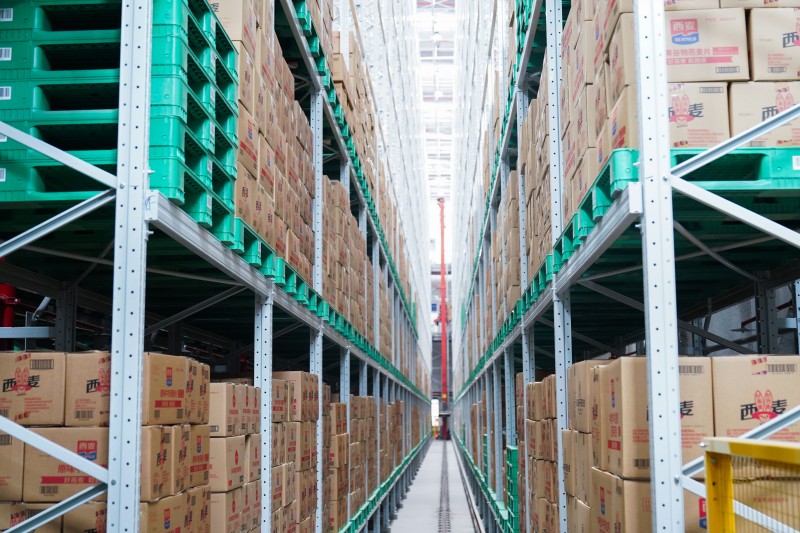In today’s fast-moving supply chain and warehouse operations, storage solutions play a critical role in ensuring efficiency, safety, and space utilization. One of the most widely adopted systems is the beam-type high bay rack, a storage method designed to accommodate palletized goods at great heights. But what makes this system unique? A beam-type high bay rack consists of upright frames and horizontal load beams that create adjustable levels for pallet storage. Its modular design allows operators to customize the number of levels, spacing, and configuration according to the load requirements. Unlike simple shelving, beam-type racks are engineered for heavy-duty usage, making them indispensable in industries such as logistics, manufacturing, food distribution, and retail. By enabling vertical storage, warehouses maximize cubic space instead of only floor area, leading to a more cost-effective operation. At the same time, the system ensures accessibility, since forklifts can directly retrieve pallets from any beam level. As automation becomes more prevalent, beam-type racks are also compatible with automated storage and retrieval systems (AS/RS), adding long-term value. To fully appreciate their importance, it is essential to explore not only what they are but also how they enhance safety, efficiency, and scalability in modern facilities.
How Does a Beam-Type High Bay Rack Improve Storage Efficiency?
The primary advantage of a beam-type high bay rack lies in its ability to optimize warehouse storage capacity. Unlike floor stacking or static shelving, this system leverages height, allowing facilities to store more pallets within the same footprint. Each rack bay can be customized with load beams placed at varying intervals, offering flexibility for handling products of different dimensions. For businesses dealing with high product turnover, efficiency is paramount. Forklift operators can quickly access individual pallets without moving others, which reduces retrieval times compared to block stacking. This selectivity minimizes handling costs and helps reduce product damage, which often occurs when items need to be shifted repeatedly.
Additionally, the open structure of a beam-type rack allows better airflow and light penetration, which can be beneficial in industries requiring climate control or hygiene standards, such as pharmaceuticals and food storage. Efficiency is also achieved through its modular nature—additional bays can be added as business needs expand, eliminating the requirement for entirely new infrastructure. Warehouses benefit from improved picking speed, reduced operational bottlenecks, and higher throughput rates. In summary, the beam-type high bay rack is not just a storage system; it is a productivity multiplier that helps businesses handle growing inventory volumes while minimizing wasted space and labor.
What Safety Benefits Come with Beam-Type High Bay Racks?
Safety is a paramount concern in any warehouse, and beam-type high bay racks are designed with structural integrity and worker protection in mind. The system uses high-strength steel uprights and load beams engineered to handle significant weight capacities. Beams are often secured with safety locks or clips that prevent accidental dislodgement during loading and unloading. This reduces the risk of racks collapsing under heavy loads. For additional stability, the racks can be anchored to the warehouse floor, ensuring they remain secure even under high traffic conditions.
Another key safety feature lies in the rack’s ability to support load distribution. By positioning pallets evenly across beams, weight stress is minimized, which prolongs the rack’s lifespan and reduces structural failures. Many warehouses also install safety accessories such as pallet supports, wire decking, and backstops, all of which help prevent items from falling during handling. The open access design allows forklift operators to maneuver safely, decreasing the risk of collisions or product damage. Moreover, compliance with recognized international safety standards ensures that racks undergo rigorous testing before installation. Proper training for staff is also an integral part of safety, as even the most durable racks can become hazardous if used incorrectly.
Why Is a Beam-Type High Bay Rack Highly Versatile?
One of the most attractive features of a beam-type high bay rack is its versatility. The system can be adapted for various industries, load types, and warehouse layouts. The adjustable beam levels mean that operators can easily accommodate different pallet sizes and weights, from lightweight cartons to heavy industrial products. The racks can be configured as single-deep for maximum selectivity or double-deep for higher density storage. This flexibility allows businesses to strike the right balance between accessibility and space optimization.
Furthermore, beam-type high bay racks can be integrated with specialized accessories, making them suitable for diverse applications. For example, wire mesh decking can support smaller items that might otherwise fall between beams, while pallet supports ensure stability for non-standard loads. Some warehouses incorporate guide rails to assist forklifts in aligning pallets accurately at higher levels, minimizing the risk of operator error. Because the system is modular, it can be expanded or reconfigured as operational needs evolve, without requiring an entirely new investment. This adaptability makes it a future-proof solution for growing businesses. Whether the goal is to increase storage density, improve picking speed, or integrate with automated solutions, beam-type racks deliver unmatched versatility.
How Does a Beam-Type High Bay Rack Compare to Other Storage Systems?
To better understand the value of beam-type high bay racks, it helps to compare them with other common warehouse storage solutions. Below is a table outlining the differences:
| Storage System | Accessibility | Space Utilization | Load Capacity | Flexibility | Best Use Case |
|---|---|---|---|---|---|
| Beam-Type High Bay Rack | High | High | Heavy loads | Highly versatile | General palletized goods storage |
| Block Stacking | Low | Medium | Limited by stability | Low | Short-term or bulk storage |
| Drive-In Racking | Medium | Very high | Heavy loads | Moderate | High-density storage of similar items |
| Cantilever Racking | High | Low | Long/bulky items | Moderate | Pipes, lumber, or sheet materials |
As seen in the table, beam-type high bay racks strike the ideal balance between accessibility and density. Unlike block stacking, they offer direct access to every pallet. Compared to drive-in systems, they provide better selectivity while still maintaining strong space efficiency. Their adaptability further distinguishes them, allowing warehouses to manage multiple product types without structural limitations. This comparison highlights why beam-type racks remain one of the most versatile and cost-effective options in modern logistics.
What Are the Key Considerations Before Installing a Beam-Type High Bay Rack?
Before investing in a beam-type high bay rack system, several factors must be carefully evaluated. The first is load capacity—each beam level must be designed to safely support the weight of the intended pallets. Overloading can lead to dangerous structural failures. Second, warehouse ceiling height and layout must be assessed, since these determine how many beam levels can be accommodated and how aisles will be arranged for forklift access. Third, forklift compatibility is crucial. Not all forklifts are designed to reach extreme heights, so businesses may need to upgrade or adjust their equipment.
Another consideration is safety compliance. Facilities should ensure that racks meet local and international standards, and that they are installed by certified professionals. Regular inspection and maintenance are also vital to prevent accidents. Additionally, companies should think about future scalability. A modular beam-type rack can be expanded as storage needs grow, making it a smarter long-term investment than fixed shelving. Cost is another factor, but it is essential to look beyond the initial purchase price and consider the total cost of ownership, which includes durability, efficiency gains, and reduced labor costs. By addressing these considerations, warehouses can maximize both the safety and efficiency of their storage infrastructure.
Frequently Asked Questions About Beam-Type High Bay Racks
Q1: How much weight can a beam-type high bay rack hold?
A: The capacity depends on the beam design and upright strength, but typically ranges from hundreds to thousands of kilograms per beam level.
Q2: Are beam-type racks suitable for automated warehouses?
A: Yes, many designs are compatible with automated storage and retrieval systems, making them adaptable for future automation.
Q3: How often should beam-type racks be inspected?
A: Regular inspections are recommended every 6 to 12 months, with additional checks after accidents or seismic events.
Q4: Can beam-type racks be reconfigured?
A: Absolutely. Their modular design allows adjustments in beam spacing, additional bays, and accessories to fit changing operational needs.
Q5: What industries benefit most from beam-type high bay racks?
A: Virtually all industries using palletized goods, including retail, manufacturing, food distribution, and logistics, benefit from this system.
Conclusion
The beam-type high bay rack is more than a storage structure—it is a strategic tool that enhances efficiency, safety, and scalability in warehouse operations. By enabling vertical storage, improving accessibility, and offering unmatched flexibility, it addresses the pressing challenges of modern supply chains. Compared with other storage systems, it delivers the best combination of selectivity, capacity, and adaptability, making it an excellent investment for businesses seeking long-term growth. With proper planning, safety compliance, and regular maintenance, beam-type high bay racks can provide decades of reliable service. For warehouses aiming to optimize operations, reduce costs, and future-proof their storage, the answer is clear: beam-type high bay racks are an essential solution.
Post time: Aug-22-2025





